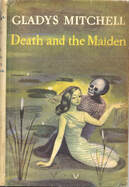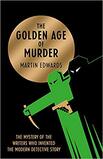Instead of organizing the conversation loosely by topic, I will let each reader have their own section, and I will throw in my own observations where they are suitable. All of us have found much to discuss and highlight in Gladys Mitchell's prose, so this installment will feature quite a few direct quotes from the lively text.
Joyka, who confides that she "could write pages on this book," begins with a reference to the previous week's note on the narrative following the form of a Morris dance. "I am grateful to Martyn for pointing out the interplay between the story and the dance. I was feeling the movement in the story but had not made the connection. It is interesting to see almost every interaction happens between pairs: Carey and Mrs. B, Fay and Jenny, Tombley and Simith, Tombley and Fay, Priest and Lender, Mrs. Ditch and Mrs. B. There are very few group scenes in this book."
That couples comment nicely introduces an element I have been tracking and ruminating on since I started Dead Men's Morris. For me, this book is sometimes quite patience-testing in its approach to the detective story template, in that we are nearly always once removed from any moment of primary importance. This, of course, is traditional to any mystery puzzle, where the murder has already occurred and the sleuth must by necessity interview suspects and witnesses and try to recreate the past to understand what happened.
But Mitchell sometimes delivers stories that can feel like the theories and conjecture are dealt out too quickly to carry weight. The reader tries to keep track of all of the potential combinations and their merits, but the discussions remain between Mrs. Bradley and the person in whom she is confiding (often her nephew Carey here). The result can be quite fatiguing, especially as a particular theory is sometimes not followed up with a present action or exchange with the person under suspicion.

Mrs. Bradley, with a veil tied under her chin to keep her hat on, and fur-lined gloves on her hands, sat patiently in the sidecar...
“Garsington!” screamed Mrs. Bradley, above the noise of the engine. “Garsington ho!” bellowed Carey, as he turned the corner and slightly opened the throttle.
“I don’t thenk at all,” said Mrs. Ditch, eyeing him calmly. “Tes a bad ’abit, and shouldn’t be encouraged en nobody. Ef us didn’t thenk, us wouldn’t make oursen miserable. That’s what I ben sayen to our dad.”
“Our Lender... trapsen and trollopsen over the country...”

"Blood," said the analyst, two days later. He had met Mrs. Bradley, by appointment, at the Detection Club, of which she had been made an honorary member, and they sat in armchairs in the larger of the rooms which overlooked the street.
They descended the dark and ancient staircase past the haunts of industry, pleasure and mystery which made up the remainder of the house and, turning into Shaftsbury Avenue, were soon at the entrance to Piccadilly Tube station, where they parted.
Next, we hear from Martyn, who shares some of his favorite literary moments. His comments this week are largely in celebration of Gladys Mitchell's wit, which, he writes, "is intelligent, playful, bountiful and sometimes laugh-out-loud funny." I quite agree – it's certainly one of the qualities that most endears me to her work. Martyn recognizes the voice of P.G. Wodehouse in Carey's reply, "If I heard pigs in trouble, I should hasten pigwards without a second thought. The whole thing is unhealthy and morbid, and strictly on the lines of the so-called maternal instinct…"
The author's descriptions of her elderly sleuth continue to be worthy of study. Martyn: "The saurian Mrs. Bradley is often compared to a boa constrictor, but these allusions become increasingly elaborate. 'Mrs. Bradley… [was] eyeing him with the maternal anxiety of a boa-constrictor which watches its young attempting to devour their first donkey.' The visual absurdity of the image is a joy. She can even include two beasts in one sentence, '…looking like a benevolent alligator and then suddenly screeching like a slightly demented macaw.'"
Martyn notes Mitchell's empathy for children and animals alike through her descriptive imagery. "Describing Nero’s discontent at the presence of humans, 'his ears were cocked like those of a suspicious, unfriendly dog, and even his tufted tail lacked that air of roguery inseparable from the appendages of pigs in general.'" Also worth honouring is the author's "artistry in depicting all registers of speech, in this case, the disintegration of grammatical laws in the sergeant’s laborious attempts at logic":
"Well, you onderstand, I can’t say in words what I mean (…) As I tell ee, u knows her work, and if us didn’t, Sir Selby do, too and all, don’t him?"
…The fat-stock prices, Oxford-on-Cam pronounced.
(Strattford-atte-Bow, quoth Chaucer)
Fie, for shame!
Hoodoo, or Voodoo – same?
Shame, same; same shame as
Eve’s.
Significant form? What else?
Squirms matter? All her dugs?
The woods were the colour of woodsmoke, and had almost the same dense obscurity… a line of trees, a thin straggle of windblown trunks and leafless arms, stood up on the crest of a ridge like ragged clouds in the wake of a windblown storm... a scarecrow brood with menace in their very shapelessness.
The post for Figure 3: Parson's Pleasure will be delivered on or about December 30. I look forward to finishing the dance!
 RSS Feed
RSS Feed